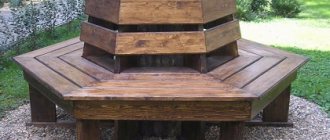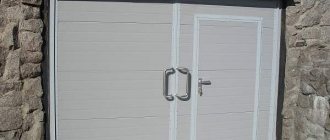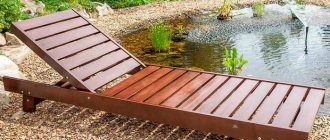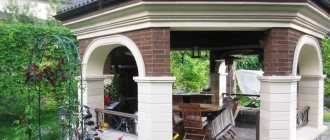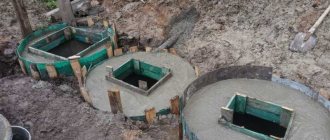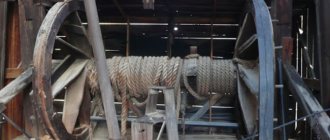People believed that through the well you could get to another world
All beliefs contained rational grain. Archaeologists confirm that well cults were spread throughout the world, and wells were equally protected among different peoples. Unfortunately, a large layer of folk culture and beliefs was lost in the 20th century. They come to us in the form of rare recordings by contemporaries and stories of old grandmothers.
Do-it-yourself well in the country: types of wells
Conventionally, all wells are divided into two groups:
- utilitarian
- decorative.
Utilitarian wells
Utilitarian wells are those that contain water; their purpose is purely practical. The most popular type of this group was and remains the classic well made of concrete rings. The water from it is fresh, clean, cool, and of high quality.
Advantages of a well made of concrete rings:
- long service life
- ease of cleaning and other maintenance
- ability to repair chips and other damage
- the opportunity to improve the well from the outside.
The Abyssinian well (needle well) is another type of utilitarian group. It looks like an inch pipe buried 15–20 meters into the ground. At the end of the pipe there is a perforated tip, shaped like a needle. The purpose of the tip is to collect groundwater.
What an Abyssinian well looks like can be seen in the photo below. Its fundamental difference is that water is pumped in forcibly. Without a pump, such a well is ineffective. Mine concrete structures are filled due to the natural flow of groundwater.
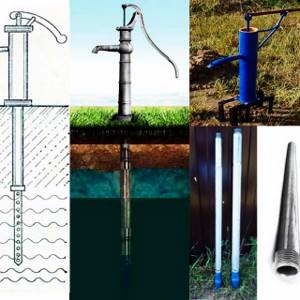
Decorative wells
Decorative wells are built as decoration for a summer cottage. They are part of the landscape design, so the aesthetic component of the object comes to the fore.
It doesn't have to be a deep well of water. To create an atmosphere, it is enough to realistically reproduce the superstructure, decorate it with a bucket, jug, flowers or other decor.

Amazing architects of India
The refined Indian culture is not understandable to everyone, but even an uninitiated person can appreciate the scale and skill of the incredible thousand-year-old wells of Ra-ni-kivav and Chand Baori. The first thing that strikes you when you see these structures is the size and amount of decoration. They were built to have constant access to groundwater and to replenish supplies during heavy rains. But dozens of unknown architects put their talent into every column and statue; there is nothing even remotely similar in any other country.
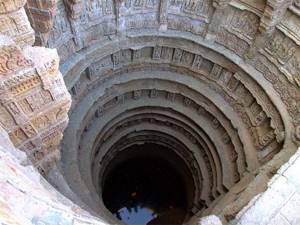
An ancient well narrows inward like an inverted cone
Rani-ki-vav was built almost a thousand years ago. The sponsor and initiator was the queen, who wanted to perpetuate the memory of her late husband. The well was located on the river bank. This is a fantastic example of a tiered stepwell. It tapers inward, like an inverted cone. The height is divided into seven tiers. There is a water intake tank at a depth of 25 meters. In total, the well is decorated with one and a half thousand statues.
Hidden under the greenish waters is a secret passage to the neighboring year, 30 kilometers long; it was supposed to become an escape route for the king in the event of a coup or war. Now the passage is blocked
The well did not last long - until the 13th century. The earthquake led to a flood of the river, and the architectural complex itself remained buried in silt until the eighties of the last century. Only a quarter of a century ago, archaeologists found and revealed to the world this beauty, the name of which is translated as “The Well of the Queen’s Steps.”
Rani-ki-vav is a marvel of ancient architecture, but it also has a rival - the Chand Baori well, whose age ranges from 800 to 1500 years. The practical application of the masterpiece is rainwater storage. The first word that comes to mind after contemplating the 30-meter stepped walls is supersymmetry. Hundreds of small steps lead down to the water reservoir. A walk to it has become the goal of a daily pilgrimage for hundreds of people. Going down is very dangerous, because the steps are not equipped with railings, and bacteriological analyzes of the water are horrifying, but guests continue to wash their feet in it and then pray to the goddess of joy and happiness. According to historical information, just a hundred years ago, the water was safe for swimming.
There are more than 200 similar ancient wells in India, but they are in deplorable condition, collapsing, resembling not monuments of world architecture, but public garbage dumps.
Do-it-yourself utilitarian well in the country: photos, videos, drawings
Making a classic well in a country house is more difficult than an Abyssinian one, but it will last 3 times longer.
Construction begins with the selection of materials. Traditionally, mine wells are equipped with reinforced concrete rings from the inside: they are strong but heavy. You won't be able to install them yourself.
The second option is prefabricated plastic rings, which weigh much lighter, cost less, and are not subject to corrosion.
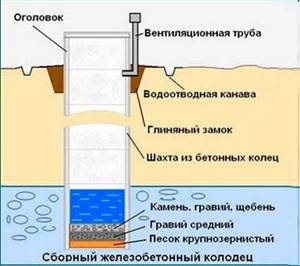
Stages of constructing a well
- At the preliminary stage, you need to choose the right place for the well. The ideal option is geological exploration of the site and precise identification of areas where there is water.
- The next stage is determining the size of the well. The diameter of the pit should be 10 cm larger than the diameter of reinforced concrete or plastic rings.
- Now you can move on to digging a hole. Its depth should be such that the ring does not completely enter it, but rises 15 cm above the ground.
- You need to lower the second one onto the concrete ring installed in the pit and secure the joints with staples and cement mortar.
- The next stage is to remove 80 cm of soil from the inside of the rings. Once this is done, you can dig a hole from the outside until the concrete rings sink to the bottom under the weight of their own.
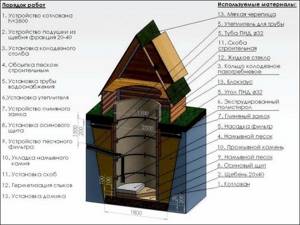
The third and fourth rings are installed in a similar way until water appears at the bottom.
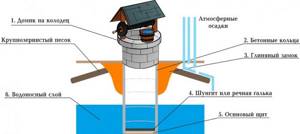
The final stage is to clean the bottom of the well, after which it must be left to fill with water for 12 hours. After 12 hours, the accumulated water will have to be pumped out and a filter installed at the bottom to protect the water from impurities.
The bottom filter consists of three layers:
- bottom layer - river pebbles, height 15 cm
- middle layer - gravel or fine crushed stone, height 10 cm
- the top layer is quartz sand, height 10 cm.
The filter is ready, the well is filling - you can move on to the superstructure. You can do it in different ways. The photographs below show examples of successful add-ons.
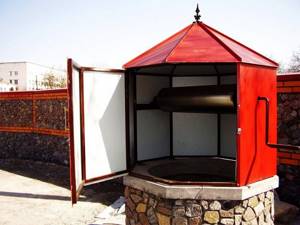
You will find a video on the topic useful.
Do-it-yourself decorative well at the dacha: photos, videos, drawings
A decorative well decorates the site, is used as a flower garden, and masks storm drains, irrigation barrels, pumps and other equipment on the site.
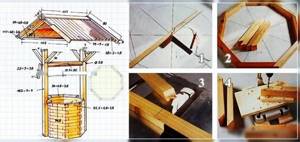
The design of a well can be budgetary or luxurious. It is important that it fits conceptually and stylistically into the design of the summer cottage. We will consider the simplest decorative well today as an example.
To make it you will need:
- block house 1.5 m long
- carriage board
- wooden blocks 40x40 mm
- edged board
- moisture resistant plywood
- fasteners.
The basis of the decorative well is a cube covered with a block house.
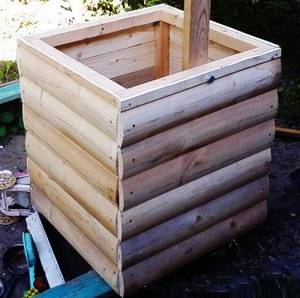
The racks on which the roof will be supported are attached to the base. The rafter frame is made of thin timber, and the slopes are reinforced with corners cut from moisture-resistant plywood.
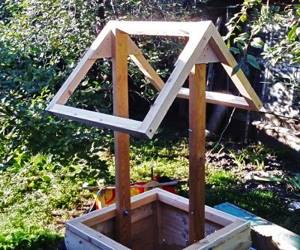
The roof is covered with clapboard, and a cylinder for a bucket and the bucket itself with flowers are used as decoration.
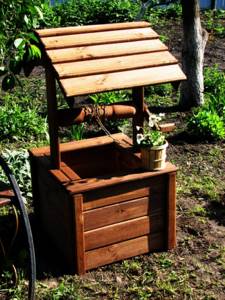
Making a well at your dacha with your own hands: photo
To decorate a well, you can use the most unexpected materials and ideas and get a nice result. Take a look at the photographs of unusual wells and see for yourself.
Ancient well of the goddess Demeter
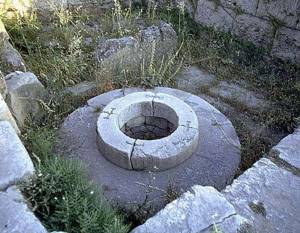
Well of Demeter - more than two and a half thousand years old
According to legend, while wandering in search of her daughter Persephone, the goddess of fertility sat down to rest at the well of Kallichore. Here the daughters of the local king received the blessing. All that remains of the well is the ancient masonry and a platform paved with slabs. The building is more than two and a half thousand years old. Later, even more ancient remains of a well were discovered near it, which may be contemporary with the sorrowful search for Demeter.
How to clean a well at your dacha with your own hands
To ensure that the water in the well is always fresh and clean, it needs to be cleaned periodically. It is advisable to carry out sanitary treatment of the well after spring floods.
The easiest way to do this is to dissolve a teaspoon of potassium permanganate in a bucket of water, then pour the liquid into the well. After 2 hours, pump out the water from the well and let it fill again.
Automated cleaning can be done in other ways. It will require deep and drainage pumps and water tanks. Using a deep pump, water will be pumped out from the well into a container, and using a drainage pump, it will be pumped back.
The pumps should be located at a distance of 50 cm from the bottom, and the deep pump hose should be as close to the bottom as possible in order to lift silt and dirt with pressure and pass them along with water through the filters. The cleaning process continues until clean water flows from the pump.
To be sure of its quality, we advise you to submit samples of purified water from the well to a laboratory. And then drink it for health benefits.
Settled nomads
Archaeological excavations often surprise scientists, forcing them to completely change their theories. A unique find and evidence of the skill of ancient people was discovered in Germany. These are the remains of a wooden well, which may become the oldest structure of this type. Part of the log house made of tightly fitted logs indicates that back in the seventh millennium BC people learned how to process wood efficiently.
Researchers suggest that the well dates back to the period when nomadic peoples became sedentary. The construction of a capital water source indicates long-term residence of people in the surrounding area.
In medieval castles, secret side passages were often installed in wells, which led hundreds of meters and sometimes kilometers away. This was a way for feudal lords to disappear unnoticed in case of danger, taking away their family and jewelry.


